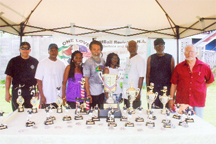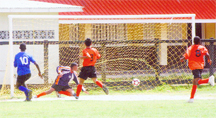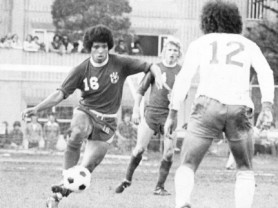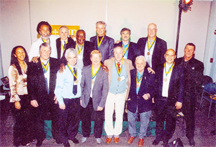Like a modern day Santa Claus Roger Alphonso visited New Amsterdam earlier this year with gifts of hope for a better township, to resuscitate primary and secondary school football and to reward a championship-winning football team.

New Amsterdam is a town that seems stagnant; a throwback to the Rip Van Winkle days, almost. It is a far cry from the 1970s when the community thrived under then Mayor Errol Alphonso. New Amsterdam is also where Roger Alphonso honed the skills that have made him easily one of the better footballers to come out of the town.
In fact Roger was so talented that he probably could have represented Guyana at a number of other sporting disciplines but football was and remains his game. Back then the standard for football was high and several players from the town were on junior and senior national football teams. Some players were so good they went on to win scholarships to colleges in the USA.
Gordon, Mark and Roger Alphonso along with Maxwell Headley are among the top players who emerged from that era. The sport was going places. Then came a lull. Perhaps it started when the Burnham Park which hosted many of the international football games including those of visiting England second division side Hull City and the Cuba national team, fell into ruin. This may have been among reasons why a group of persons formed the New Amsterdam Primary Secondary Schools Football Foundation (NAPSS).

NAPSS is headed by Gladstone Prass with Roger serving as vice president. The group decided to invest in football and to stage a tournament for primary and secondary schools and a `Reunion of Champions’ awards ceremony to acknowledge the victorious 1970 New Amsterdam/Canje football team which won the countrywide Guyana Primary School Football tournament. With the hard-working Marcia Paul- Ross, Petra Forde, Mark Bradford, Neil `Grizzly’ Humphrey and Avia Lindie, the event held from August 7-17, was deemed a success.
Roger is a two-time inductee into the NCAA Hall of Fame (Class of `76 and Class of `78). He lists a meeting with football great Eusibio in 1995 as… “One of my career highlights.” But his biggest pleasure undoubtedly came when his 1976 USF team defeated Clemson in the semi-finals of the NCAA tournament. This is what the Arawak newspaper reported of the game:

“The Alphonso family of New Amsterdam, in Guyana, must have been proud when brothers Gordon and Mark Alphonso, 22 and 23 respectively commandeered Clemson University to the semi-finals of the NCAA Soccer Championship in Philadelphia last December 13.
“In the semi-final match with the University of San Francisco Dons, The Clemson Tigers fell 0-1, but with no shame to the Alphonsos. They had been undone by their youngest brother Roger, 19, a freshman and striker for the Dons. “The Dons went on to edge the University of Indiana, 1-0 in the final and capture the event for the second successive year.
“Alphonso, Roger, that is, finished the season with 12 goals second only to Tony Gray of Liberia, who totalled 14 for the season.”

In the following interview Roger talks with Stabroek News’ Sports Editor Donald Duff about the NAPSS tournament, his career at the University of San Francisco and of plans to help Guyana’s football reach the World Cup finals.
DD: How did you feel about being inducted into the USCF Soccer Hall of Fame?
RA: Great, great accolade just to be a Hall of Famer, my name and country would never be erased and that accomplishment is worth everything to me.
DD: Are you the first Guyanese to be inducted into that particular Hall of Fame.
RA: Yes, clearly, I’m the first Guyanese to be inducted into the USCF Hall-of-Fame and only Guyanese to be on the NCAA Soccer Championship team.
DD: Now that is obviously a tremendous honour and achievement what would your career highlights be like at the University of San Francisco.?
RA: Out of my four years in college we won the NCAA title twice in `76 and `78 and in `77 we were runners-up so winning two NCAA titles clearly is an outstanding achievement.
DD: What was the standard like back then? Were there like a lot of foreign players from places where the standard of soccer was basically high.?
RA: Yeah in the 70s when I was accepted at USF there was a strong influx of overseas players former national players of Nigeria, Norway, Liberia etc., and the standard of soccer was very high and coming from New Amsterdam I matched their skill and the university benefited from all of that and we were the best in the country for several years.
DD: And so now you’ve come back home to sort of start a new programme with the NAPSS. What was it like the initial inaugural awards ceremony and competition?
RA: Very motivational, very encouraging quite pleased and impressed with the local coaching staff. It was reflective in the athletes revealing good discipline and great skill, so, being here for the two weeks, what I saw has motivated me to produce more the next time we come and I’m anticipating returning to the States and getting more people involved with sponsorship etc.
DD: What’s the goal of NAPSS?
RA: The goal of NAPSS is to produce footballers that can make Guyana reach the World Cup finals. NAPSS is attacking primary and secondary school athletes with the hope of moulding them with the aim of Guyana playing its first ever World Cup finals match.
DD: Do you see the need to start them very young so as to instil in them the right coaching at a tender age.?
RA: Clearly. The nursery programme where from primary school to secondary school to club to national level, the most important aspect of that is the primary school that’s where the athletes could be trained properly and get an over standing of what it is to be a professional soccer player that could help Guyana go to the World Cup finals.
So we’re introducing a coaching style for children this coaching technique was created at Stanford University and the basic concept of the coaching is called Positive Coaching Alliance.
So if you give an athlete a negative comment the concept of the coaching is to give him five positives. So we’ll be emphasizing this to the coaching staff here in New Amsterdam and eventually once the coaches get the programme they will transfer it to the youths and we would assure the youths they will be better citizens whether they become national players or not. They will be equipped with good etiquette to live a fulfilled life beyond soccer.
DD: You were viewed as a child prodigy as a youngster in the sense that your skill level was way above young players of a similar age, what was responsible for that.?
RA: Coming from the town of New Amsterdam during the `70s we were in an era of self-help and in those times we would have been training at five o clock in the mornings before we went to school for seven and those things, without us knowing, prepared us and gave us the self confidence and the ability to match the skills of others and I was quite fortunate to be around people like “Fuzzy” Madramootoo, “Jukka” Bollers and these all greats from New Amsterdam, and again nothing comes easy it was practice, practice, practice never thought of myself as a prodigy but clearly returning here is similar to what prodigies do they return to where they get their skills from and that’s what NAPPS is about Roger returning to New Amsterdam soccer from where he got it from.
DD: But you also seem to have gotten it from your family because you have two older brothers that were national players and who were very versatile in their own rights. What role did Gordon and Mark play in your football development?
RA: Gordon and Mark were defensive players, both national players and the role they played in my game was to teach me how to protect myself and that formulated a skilful type of player which I became and thanks to Gordon and Mark for their roughness, I became this quote unquote “skilful type of player” and continued to hone my skills overseas and thanks to them I am what I am today.
DD: They also paved the way for you I think both of them managed to acquire scholarships would you like to elaborate on that.
RA: Yes, Gordon achieved the first scholarship out of New Amsterdam to Clemson University himself and five other players from Georgetown, and that, and with him being so successful that paved the way for Mark Alphonso and Maxie Headley another New Amsterdam player who was invited to go to Clemson. Now with the Alphonsos being represented at Clemson my family thought it best for me to go on the other side of America to California at the University of California at the University of San Francisco. That worked out well enough where USF my school met Clemson University in the NCAA semi-finals in 1976 in which younger brother Roger was able to beat Clemson, Maxie Headley, Mark Alphonso and Gordon Alphonso.
DD: What is your impression of the Guyana National team, I don’t know if you have seen the team in action. I know that you did play for Guyana as late as 1984 in the World Cup preliminaries. What’s your assessment?
RA: Clearly it’s improving somewhat the Digicel tournament two years ago beefed our football up but clearly to be a World Cup nation there must be World Cup preparations and it’s evident that these things are costly and the Guyana Football Federation is clearly in need of more funds to produce a better national team. Now with the creation of NAPSS we are hoping that New Amsterdam and Berbice will be able to inject several players into the national team and propagate them into our first World Cup Finals game.
DD: Have you done any coaching at any level at all.
RA: Am, yes. I’ve been the coach for my club team it’s and over 30 senior division team. I was privileged to coach the San Francisco Ethiopian team which plays in an annual US five million dollars tournament. So my coaching has been somewhat limited but the experience and the desire to be a better coach is there and I’ll be honing those skills as time progresses.
DD: Will you be available if called upon to serve in any capacity to help uplift Guyana’s football.
RA: Certainly, the move of NAPSS, or the creation of NAPSS is in that vein to give back to Guyana’s football on a big scale and I certainly will be quite open to any role in helping Guyana to its first World Cup final game.
DD: Could you tell me a bit more about your stint at the University. What did you major in?
RA: I studied Physics at the university and I am a graduate with an engineering Physics degree which I utilize as an engineering tech with a software company Atari.
From Atari I branched off and became a self-made businessman. I run a small landscaping business in California.
DD: What’s it like to be back home. You obviously spent a long time abroad. You certainly have not forgotten Guyana and certainly not New Amsterdam. You seem very willing and able to want to give back substantially to this small town unlike a lot of others who have migrated. How do you find coming back home. Do you find the area conducive for you to further channel your energies towards the development of football?
RA: Yes! Clearly, New Amsterdam is inspiring. I have a strong desire to bring back the phrase “self help” for I think if we can produce leaders amongst each other we could create this self-help that we are aware of and get things done for ourselves instead of waiting for things to be done. So returning home I am driven to coordinate footballers in general to help ourselves so the youths can benefit. So coming home very motivated I see the population increase and I see the desire for good leadership for sports and I hope that I can fit in somewhere or the other. This NAPSS energy we have and I am looking forward to being in Guyana every two years.
DD: When will be the next NAPSS tournament?
RA: In 2011. Our inaugural tournament only touched the high school/secondary school level. Our next tournament would include the primary and secondary schools simultaneously. So in two years we expect to be dealing with 300 athletes for the two weeks spell and we are looking forward to that and there are sponsors in the US who will be looking forward to the media coverage that we got this time and quite confident of better and better things to come.
DD: Would you be looking for sponsorship from the local community or is NAPSS only to be funded by expatriates.
RA: Clearly NAPSS is overseas based we would want all of our generated income from the US but NAPSS has opened a business account in New Amsterdam and we are quite capable of accepting local sponsorship of any form private or from the commercial sector.
DD: Where do you hope to see NAPSS in another couple of years?
RA: I would like to see NAPSS with a head office and within the head office I would like to see NAPSS hosting or creating a soccer store where we could see NAPSS supplying soccer gears to New Amsterdam and Guyana at large.
DD: Your final thoughts.
RA: Guyana is doing well. I read about Guyana and I came and I saw the construction boom etc. looking forward to adding to the greatness of Guyana especially in New Amsterdam through sports and soccer. NAPSS is born we’re here to produce the first ever World Cup team for Guyana, hopefully NAPSS will have representation in that game.
DD: Merry Xmas NAPSS. Best of luck with your next tournament in 2011.





